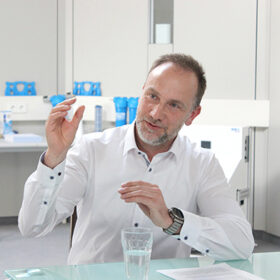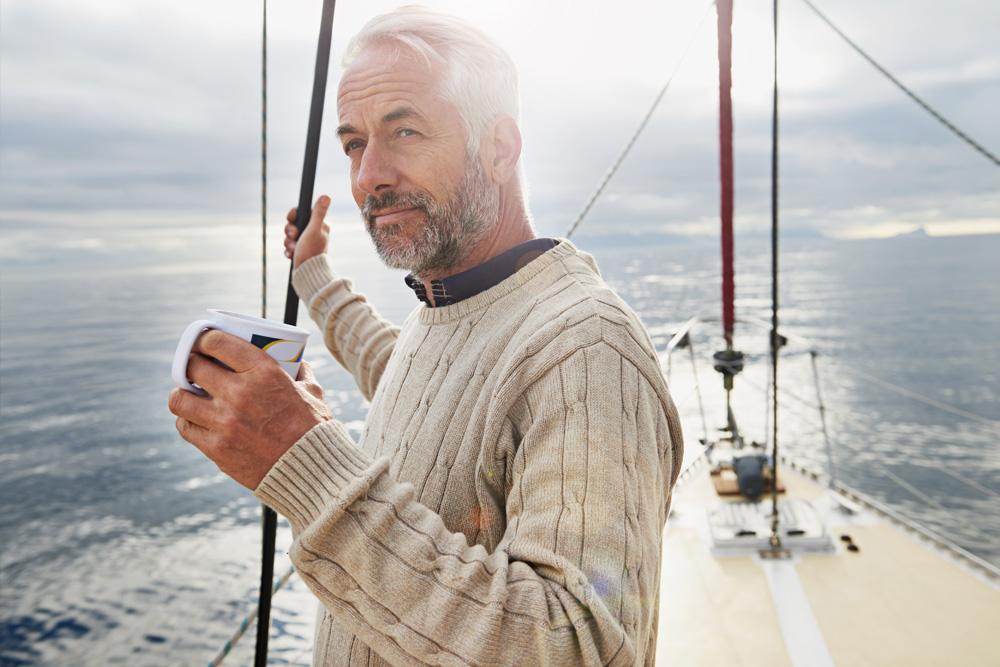
Why does the quality of the fresh water in the motorhome play an important role – even if I don’t drink the water?
I encounter this question again and again. Basically, you need to know that in drinking water, even in Germany according to the current German Drinking Water Ordinance and high quality standards, 100 CFU (germ-forming units: bacteria, fungi, yeasts, etc.) are allowed per 1ml of water in drinking water, as well as the fact that microorganisms also multiply faster with increasing temperature. From approx. 10°C onwards, the bacteria start to multiply, and at 25°C, for example, the growth rate is already tripled. Boilers in recreational vehicles are usually operated at temperatures between 40°C u. 60°C. This makes sense from an energy point of view, but is disadvantageous from a hygiene point of view. According to a recent study by the Helmholtz Centre for Infection Research (HZI) in Braunschweig, Germany, Legionella bacteria, for example, also multiply at temperatures between 50°C and 60°C [1]. If you have an intact immune system and drink Legionella contaminated water, the risk of contracting the disease is very low.
But things look different when it comes to showering at the latest. Respirable Legionella aerosols can be inhaled via the fine water mist produced during showering. These cause long-term damage and can cause serious infections such as legionellosis (pneumonia).
“Even if you use the water exclusively for washing dishes, there should be some basic hygiene of the water, I think.”
How to evaluate the risk of legionella in the fresh water system? The health consequences of Legionella in the fresh water system can be drastic and should not be underestimated. In Germany, for example, approximately 32,000 people contract pneumonia caused by Legionella every year, with a mortality rate of about 6%. This is approximately 1920 deaths per year [2]. By comparison, there were 2,724 traffic fatalities in Germany in 2020 [3].
Accordingly, what do you recommend for hygienic operation of the fresh water system?
My practical recommendation is to carry out a basic cleaning of the fresh water system at least once a year, to conserve the water as a matter of principle and, in southern or non-European countries, to additionally disinfect the water due to the higher germ count. I am often asked why it is still necessary to clean the fresh water system when the water is preserved. This is explained quite simply: the water loaded with silver ions is largely protected against germination – however, it is technically impossible to guarantee 100% sterility in the entire system. Think alone of the filler neck or other parts of the fresh water system that are not constantly in contact with water, but are constantly wet due to the evaporation of the water. This provides excellent conditions for germs to multiply, which in the long term form a biofilm in the tank and the lines, which in turn increasingly contaminates the entire system.
This is then not only disgusting and unappetizing, but can also become very unpleasant odor. And depending on the degree of contamination and the type of germs or bacteria, this can also have adverse health effects.
“My recommendation is to do a basic cleaning of the fresh water system at least once a year, to basically conserve the water, and in southern or outside Europe, to additionally disinfect it due to the higher germ count.”
What’s the deal with silver as a preservative?
Already thousands of years ago people were aware of the special properties of silver. Even Alexander the Great considered it essential to carry the drinking water needed for various campaigns in silver containers to ensure its purity. Traditions from this time already describe the magical, healing properties of silver. Today, people take a more sober view – they now talk about silver and the antimicrobial effect as a result of the oligodynamic effect. In drinking water, silver ions (Ag+) have a microbicidal (germ-killing or germ-inhibiting) effect. This makes it possible to preserve drinking water and protect it from recontamination in the long term. In this way, the water loaded with silver ions can even be protected from recontamination for up to 6 months [4].
“In drinking water, silver ions (Ag+) have a microbiocidal effect. This makes it possible to preserve drinking water and protect it from recontamination in the long term.”
Which active ingredients are useful for preservation?
In the case of silver, it is the positively charged silver ions that dock onto the microorganisms (e.g. pathogens such as Legionella, E.Coli, etc.) and disrupt the metabolism of the bacteria or lead to cell death in over 30 different mechanisms of action. There, mainly thiol and carboxyl groups form relatively stable compounds with the silver ions [5], which lead to a loss of the ability to multiply after several minutes or to cell death as a result of metabolic breakdown. Products based on chlorine or e.g. hydrogen peroxide cannot be “bound” in water, volatilize and are therefore unsuitable for preservation.
“The microbially active silver ions have a unique long-term effect unlike any other active ingredient on the market.”
Which limit values are regulated according to the Drinking Water Ordinance?
The World Health Organization (WHO) recommends a maximum silver ion concentration of 0.1mg silver (100µg) per liter for the preservation of drinking water; this has been agreed upon internationally. In Germany, silver has no longer been listed in the Drinking Water Ordinance since the end of 2017 (until then, the addition was also 100µg/l). However, this has no relevance for campers or e.g. motorhome renters. The list only regulates treatment materials for public water utilities.
“The European standard EN 15030 (in Germany: DIN EN 15030) deals with the preservation of water. Here, reference is made exclusively to the active ingredient silver(-ion) when it comes to water preservation.”
Is silver in drinking water a health concern?
First. So far, no scientific study can be reported that has demonstrated a harmful effect on the human organism in the above-mentioned concentrations. This is mainly due to the fact that silver ions, which are absorbed into the human organism, leave the human body again or are excreted via the stool [6]. I would be happy to illustrate the harmlessness with a calculation example:
Imagine drinking 2 liters of water every day for 70 years with 0.1mg (100µg) of silver per liter of drinking water (internationally recognized maximum concentration of silver in drinking water). This would correspond to a total silver quantity of 5g silver within 70 years (0.0001g/l * 2l/day * 365days/year * 70 years). A report of the World Health Organization (WHO) shows that the value of 5 grams of ingested silver does not have a toxic effect in the human body, precisely because a large part is excreted again via the stool. Thus, even a lifetime consumption of 2 liters of drinking water, with the maximum recommended silver ion concentration of 0.1mg/liter of drinking water, does not pose any health risks [7]. Now if you break that down to the few “camping days”, you are very likely to be even in the milligram range of ingested silver in the 70 years of water consumption. Also, the cities of Atlanta, Denver or New York have always had natural silver levels of 200 – 300µg/l. Here, no adverse effects on the health of the affected population were found, even with continuous consumption of silver amounts in the above-mentioned concentration [8].
“To date, no scientific study can be reported that has demonstrated a harmful effect on the human organism at the above concentrations.”
What is the difference between preservation and disinfection?
Preservation is the prevention of microorganisms from multiplying over a long period of time. However, this requires water of drinking water quality. Disinfection is based on the assumption that there is a high germ load in the water, which is reduced by adding disinfectants to make the water drinkable.
Chlorine-based disinfection products often have the same smell/taste – are there any alternatives?
Yes, there are. The first thing to do here, however, is to take a step back to distinguish the technologies. Basically, there are two main categories. There is chemical disinfection, as is the case with chlorine, for example, or physical disinfection, which does not require the use of chemical products. As a chemical alternative to chlorine, the active ingredient chlorine dioxide should be mentioned here, which has considerable advantages over chlorine. For example, less harmful organic disinfection by-products such as THM (trihalomethanes) are formed when chlorine dioxide is used, and it is stable and effective at higher pH levels. Here, chlorine loses its disinfection effect quite quickly [9].
Physical disinfection technologies naturally have the clear advantage here that no chemical additives are used. Sterile filters with a filter fineness <0.2µm (smaller than 0.0002mm), for example, have excellent bacterial retention. However, a clear disadvantage on the one hand are the running costs due to the 6-monthly filter changes, which must be strictly adhered to from a hygienic point of view, as well as the expected flow losses due to the filter fineness of the filter elements. A very convenient variant of physical disinfection, on the other hand, is provided by UV systems, for example. Here, the water flows through a water disinfection unit directly at the water withdrawal point, providing a freshly disinfected water.
You can also find more information on the topic of “silver in drinking water” in our interview with Camperstyle (german only): www.camperstyle.de/silberprodukte-im-frischwassertank-teil-2-interview-mit-wm-aquatec
References:
[1] R.Lesnik, I. Brettar & M.G. Höfle 2015: Legionella species diversity and dynamics from surface reservoir to tap water: from cold adaptation to thermophily. The ISME (International Society for Microbial Ecology) Journal (2015), 1-17; doi: 10.1038/ismej.2015.199
[2] Basics of drinking water hygiene and legionella prophylaxis 6th round table for hygiene officers from inpatient care facilities in the Munich city area on 13.11.2018 Referat für Gesundheit und Umwelt der LH München (Department of Health and Environment of the City of Munich)
[3] https://de.statista.com/statistik/daten/studie/185/umfrage/todesfaelle-im-strassenverkehr/
[4] DIN EN 15030:2015-05, Products for the treatment of water intended for human consumption – Silver salts for non-systematic use; German version EN 15030:2012+A1:2015, A.1.2.1 Action
[5] DIN EN 15030:2015-05, Products for the treatment of water intended for human consumption – Silver salts for non-systematic use; German version EN 15030:2012+A1:2015, 1. fields of application
[6] West, H.D. et al., The use of radioactive Silver for detection of Abzesses and Tumors, J. Lab. and clinical Medicine, 34, 1949, S. 1976 – 1979
[7] Guidelines for drinking-water quality, 2nd ed. Vol. 2. health criteria and other supporting information. World Health Organization, Geneva, 1996
[8] Water Quality and Treatment, 2nd. ed., J Am. Water Works Ass., New York 1951
[9] Höll, Karl: Water: use in the cycle, hygiene, analysis and evaluation / Karl Höll. Ed. by Prof. Dr. rer. nat. Andreas Grohmann. – 8th, completely revised. ed. – Berlin; New York: de Gruyter, 2002; 9.5.2 Chlorine and chlorine-releasing substances ff.






